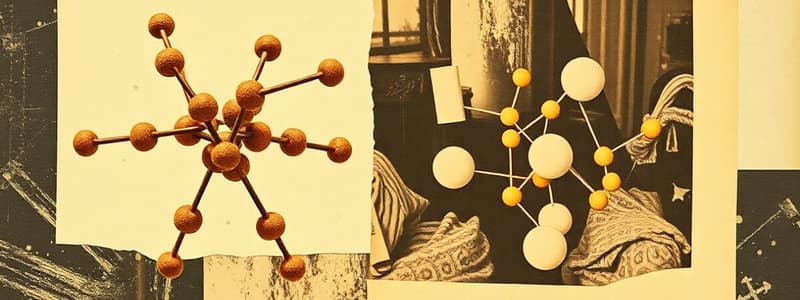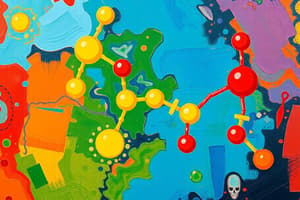Podcast
Questions and Answers
Which glycosidic bond configuration is present in maltose?
Which glycosidic bond configuration is present in maltose?
- α(1→2)
- N-glycosidic
- α(1→4) (correct)
- β(1→4)
What type of disaccharide is sucrose classified as?
What type of disaccharide is sucrose classified as?
- Polysaccharide
- Reducing disaccharide
- Amino disaccharide
- Non-reducing disaccharide (correct)
Which enzyme is responsible for hydrolyzing sucrose?
Which enzyme is responsible for hydrolyzing sucrose?
- Invertase (correct)
- Amylase
- Maltase
- Lactase
Which of the following contains a β(1→4) glycosidic bond?
Which of the following contains a β(1→4) glycosidic bond?
What is the composition of isomaltose?
What is the composition of isomaltose?
Which sugar is referred to as invert sugar after hydrolysis?
Which sugar is referred to as invert sugar after hydrolysis?
Which type of linkage connects sugar to nitrogen in N-glycosides?
Which type of linkage connects sugar to nitrogen in N-glycosides?
What is a characteristic feature of reducing disaccharides?
What is a characteristic feature of reducing disaccharides?
What distinguishes homopolysaccharides from heteropolysaccharides?
What distinguishes homopolysaccharides from heteropolysaccharides?
Which component primarily defines the water solubility of starch?
Which component primarily defines the water solubility of starch?
Which polysaccharide serves as the primary energy storage molecule in animal cells?
Which polysaccharide serves as the primary energy storage molecule in animal cells?
What type of glycosidic linkages are found in amylose?
What type of glycosidic linkages are found in amylose?
Which statement is true regarding glycogen's structure?
Which statement is true regarding glycogen's structure?
What is the primary function of cellulose in plants?
What is the primary function of cellulose in plants?
Which characteristic is shared by both starch and glycogen?
Which characteristic is shared by both starch and glycogen?
Which feature is not typically associated with polysaccharides?
Which feature is not typically associated with polysaccharides?
Which of the following describes a reaction that produces sugar acids?
Which of the following describes a reaction that produces sugar acids?
What characterizes deoxy sugars?
What characterizes deoxy sugars?
Which amino sugar is commonly found in glycoproteins and involved in the synthetic pathway in connective tissues?
Which amino sugar is commonly found in glycoproteins and involved in the synthetic pathway in connective tissues?
What type of acid is formed by the oxidation of both the carbonyl carbon and the last hydroxyl carbon in a monosaccharide?
What type of acid is formed by the oxidation of both the carbonyl carbon and the last hydroxyl carbon in a monosaccharide?
Which of the following compounds is a sugar alcohol derived from glucose?
Which of the following compounds is a sugar alcohol derived from glucose?
What happens during the phosphorylation of a monosaccharide?
What happens during the phosphorylation of a monosaccharide?
Which of the following correctly identifies a sugar acid resulting from the oxidation of glucose?
Which of the following correctly identifies a sugar acid resulting from the oxidation of glucose?
Which statement about amino sugars and their acids is true?
Which statement about amino sugars and their acids is true?
What is the main structural difference between glycogen and amylopectin?
What is the main structural difference between glycogen and amylopectin?
Which statement about cellulose is correct?
Which statement about cellulose is correct?
What primarily distinguishes chitin from cellulose?
What primarily distinguishes chitin from cellulose?
What is the composition of dextrans?
What is the composition of dextrans?
Which of the following statements about inulin is true?
Which of the following statements about inulin is true?
What role do cellulolytic microorganisms play in relation to cellulose?
What role do cellulolytic microorganisms play in relation to cellulose?
Which sugars are produced when inulin is hydrolyzed?
Which sugars are produced when inulin is hydrolyzed?
Flashcards
What are sugar phosphates?
What are sugar phosphates?
Phosphorylation reactions involve attaching a phosphate group to a sugar using enzymes called 'protein kinases'. The phosphate donor is adenosine triphosphate (ATP).
How are sugar acids formed?
How are sugar acids formed?
Sugar acids are formed by oxidizing a sugar's carbonyl carbon, last hydroxyl carbon, or both.
What are aldonic acids?
What are aldonic acids?
Aldonic acids are formed by oxidizing the carbonyl carbon of an aldose to a carboxylic acid group. Example: glucose is oxidized to gluconic acid.
What are uronic acids?
What are uronic acids?
Signup and view all the flashcards
What are aldaric acids?
What are aldaric acids?
Signup and view all the flashcards
What are sugar alcohols?
What are sugar alcohols?
Signup and view all the flashcards
What are deoxy sugars?
What are deoxy sugars?
Signup and view all the flashcards
What are amino sugars?
What are amino sugars?
Signup and view all the flashcards
Glycosidic bond
Glycosidic bond
Signup and view all the flashcards
N-glycosidic bond
N-glycosidic bond
Signup and view all the flashcards
O-glycosidic bond
O-glycosidic bond
Signup and view all the flashcards
Disaccharide
Disaccharide
Signup and view all the flashcards
Reducing disaccharide
Reducing disaccharide
Signup and view all the flashcards
Non-reducing disaccharide
Non-reducing disaccharide
Signup and view all the flashcards
Sucrose
Sucrose
Signup and view all the flashcards
Maltose
Maltose
Signup and view all the flashcards
What are polysaccharides?
What are polysaccharides?
Signup and view all the flashcards
What are homopolysaccharides?
What are homopolysaccharides?
Signup and view all the flashcards
What are heteropolysaccharides?
What are heteropolysaccharides?
Signup and view all the flashcards
What is starch?
What is starch?
Signup and view all the flashcards
What is amylose?
What is amylose?
Signup and view all the flashcards
What is amylopectin?
What is amylopectin?
Signup and view all the flashcards
What is glycogen?
What is glycogen?
Signup and view all the flashcards
What is cellulose?
What is cellulose?
Signup and view all the flashcards
Liver glycogen response to blood glucose
Liver glycogen response to blood glucose
Signup and view all the flashcards
Muscle glycogen structure
Muscle glycogen structure
Signup and view all the flashcards
Cellulose structure and function
Cellulose structure and function
Signup and view all the flashcards
Cellulose digestion in humans
Cellulose digestion in humans
Signup and view all the flashcards
Chitin structure and function
Chitin structure and function
Signup and view all the flashcards
Dextrans and dextrins
Dextrans and dextrins
Signup and view all the flashcards
Inulin structure and function
Inulin structure and function
Signup and view all the flashcards
Inulin digestion and biomedical importance
Inulin digestion and biomedical importance
Signup and view all the flashcards
Study Notes
Carbohydrate Chemistry
- Carbohydrates are crucial for various biological functions, serving as structural components and energy sources.
- Monosaccharides are the most basic units of carbohydrates.
- Derivatives of monosaccharides include sugar phosphates, sugar alcohols, sugar acids, deoxy sugars, and amino sugars.
Derivatives of Monosaccharides
- Sugar Phosphates: These derivatives are involved in phosphorylation reactions, catalyzed by protein kinases using ATP as a phosphate source.
- Sugar Alcohols: Monosaccharides can be reduced to sugar alcohols at the carbonyl carbon. Examples include glucose to sorbitol, galactose to dulcitol, and mannose to mannitol.
- Sugar Acids: Oxidation of the carbonyl group or terminal hydroxyl group results in aldonic acids and uronic acids. Glucose can be oxidized into gluconic or glucuronic acid.
- Deoxy Sugars: These sugars have a hydroxyl group replaced by a hydrogen atom. Deoxyribose, found in ATP and DNA, is an example. L-Fucose is found in glycoproteins.
- Amino Sugars: The hydroxyl group at carbon number 2 is replaced by an amino or acetyl-amino group. Examples include glucosamine, galactosamine, and mannosamine. Sialic acid is a nine-carbon amino sugar.
Glycosidic Bonds
- Glycosidic bonds link monosaccharides to form disaccharides and polysaccharides.
- Bonds are named based on the position of the anomeric carbon and whether it's an alpha or beta configuration.
- A(1-4) and A(1-6) glycosidic bonds are examples.
Disaccharides
- Disaccharides are composed of two monosaccharide units linked by a glycosidic bond.
- Examples of reducing disaccharides include maltose and lactose which contain a free aldehyde or keto group. Sucrose is a non-reducing disaccharide, lacking a free aldehyde or keto group.
Polysaccharides
- Polysaccharides are long chains of monosaccharides linked by glycosidic bonds.
- Homopolysaccharides contain one type of monosaccharide unit, while heteropolysaccharides contain two or more.
- Examples of homopolysaccharides include starch, glycogen, and cellulose.
- Starch, composed of amylose and amylopectin, is a storage carbohydrate in plants.
- Glycogen is a storage carbohydrate in animals.
- Cellulose is a structural component of plant cell walls.
- Chitin is a structural component of arthropod exoskeletons.
- Dextrans are bacterial polysaccharides.
Other Carbohydrates
- Inulin is a fructose polymer.
Studying That Suits You
Use AI to generate personalized quizzes and flashcards to suit your learning preferences.




